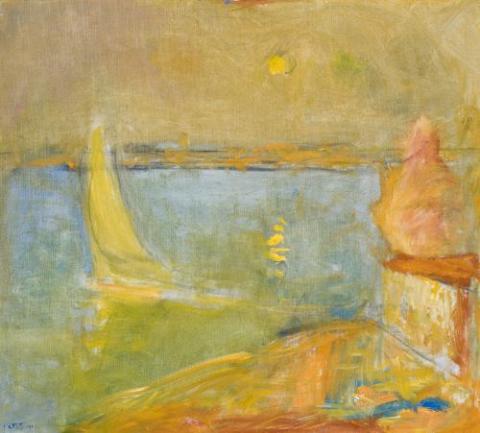SAILING BOATS ON THE DERWENT, 1981
Lloyd Rees
oil on canvas
93.5 x 104.0 cm
signed and dated lower left: L REES 81
Vivienne Sharpe, Sydney
Private collection, Sydney
If there is one thing I want now, it is for my paintings to be light right through.One of the great things the impressionists did, probably not consciously, was to bring back what the great fresco schools of Italy had achieved, the sense of the painting being on a light background. This is what I'm trying to do here, to make lightness of the canvas the dominating thing.'1
Although light had always been important to visionary artist Lloyd Rees, it was not until late in his career that it would feature as the main protagonist. No longer simply a physical phenomenon providing atmosphere and effects, light in these mature works is now more symbolic in nature, representing the totality of existence. If drawing inspiration from the work of Van Gogh and particularly, his symbolic use of the sun as a motif for the fullness of life and height of passion, Rees nevertheless departs from his artistic predecessor in figuring the sun as a spiritual entity - 'The Source' which creates and unites the world, providing a sense of endless peace and calm.
Over the years, Rees has often been described as 'the Australian Claude'2 and certainly, his compositions such as the present bear strong affinities with the scenes engulfed in light imagined by Claude Lorrain and his later British rival, J.M.W. Turner. Capturing the view from his son's house overlooking the Derwent in the Hobart suburb of Sandy Bay, Sailing Boats on the Derwent 1981 is a superb example from the Tasmanian suite of paintings and works on paper which Rees executed during the early eighties. Uniting figuration with abstraction, the artist here employs the blue of contemplation and yellow of life to immortalise that transitional moment when reality and reason surrender to imagination and feeling. Imbued with the timeless, universal emotions of serenity and hope, indeed the work is a poignant meditation by the artist in his final years upon the eternal cycle of life- the fact that light will always prevail over darkness, day will follow night, youth will learn from old age.
1. Rees , L., The Age, 1982 cited in Pearce, B., Australian Art in the Art Gallery of New South Wales, Sydney, 2000, p.287
2. Daniel Thomas cited in Foreword, Lloyd Rees: The Tasmanian Suite, Bonython-Meadmore Gallery, Woollahra, 1987
VERONICA ANGELATOS
